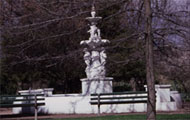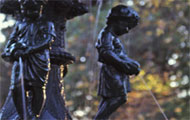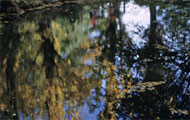- Swimming
- Interview :: Mick Munroe
- Interview :: Andrew Jennings
- Boating
- Interview :: Bob and Carol Lewis
- Interview :: John Southwood
- Object :: Kayaks
- Object :: John Southwood's Kayak
- Object :: Olympics Blazers
- Fishing
- Interview :: Kevin Laughton
- Object :: Brown Trout
- Object :: Fly Lines
- Object :: Fishing Rods
- Object :: Golden Perch
- Object :: OTAS Memorabilia
- Parks, Gardens and Fountains
- Interview :: John Chappell
- Object :: Water Stress Sculpture
Parks, gardens and fountains
Orange has long been renowned for its magnificent parks with their abundance of mature trees and the seasonal glory of its tree-lined streets. Orange's climate is particularly suited to deciduous trees common in Europe and northern Asia, which flourish in its four distinct seasons. In spring the district is a picture, with blossom from the ornamental trees in the city to the pome and stone fruit varieties in district orchards. In autumn the city is ablaze with colour as deciduous trees prepare to lose their leaves.
Most of the open space in Orange is low-lying wetlands although no river as such runs through the city. Robertson Park was originally a swampy area through which Blackman's Swamp Creek flowed. In 1882 it was converted into a park and named after former NSW Premier John Robertson.
The Seed Fountain, located in the Civic Precinct near the City Library and Regional Gallery, was made by renowned Australian sculptor Bronwyn Oliver in 1997. The fountain evokes the great importance of water in the life and economy of the Orange district, with its 'drawing up of the water of life' imagery. The water used in this fountain is recycled, supporting the notion of the fragile continuity of nature’s cycles.
Though a relatively recent addition, Orange's Botanic Gardens are fast becoming one of the city's favourite recreational areas. Displaying a variety of native and exotic specimens, the gardens embrace both the traditional and contemporary approach to open space. While the focal point in the city's older parks is often a fountain, a billabong takes pride of place in the Botanic Gardens.


